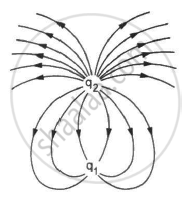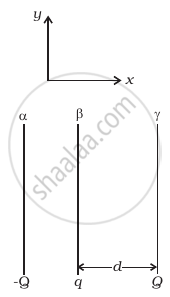Advertisements
Advertisements
प्रश्न
A point charge is taken from a point A to a point B in an electric field. Does the work done by the electric field depend on the path of the charge?
उत्तर
Electrostatic field is a conservative field. Therefore, work done by the electric field does not depend on the path followed by the charge. It only depends on the position of the charge, from which and to which the charge has been moved.
APPEARS IN
संबंधित प्रश्न
Explain the meaning of the statement ‘electric charge of a body is quantised’.
When a glass rod is rubbed with a silk cloth, charges appear on both. A similar phenomenon is observed with many other pairs of bodies. Explain how this observation is consistent with the law of conservation of charge.
It is now believed that protons and neutrons (which constitute nuclei of ordinary matter) are themselves built out of more elementary units called quarks. A proton and a neutron consist of three quarks each. Two types of quarks, the so called ‘up’ quark (denoted by u) of charge (+2/3) e, and the ‘down’ quark (denoted by d) of charge (−1/3) e, together with electrons build up ordinary matter. (Quarks of other types have also been found which give rise to different unusual varieties of matter.) Suggest a possible quark composition of a proton and neutron.
Does the charge given to a metallic sphere depend on whether it is hollow or solid? Give reason for your answer.
Consider the situation shown in the figure. What are the signs of q1 and q2? If the lines are drawn in proportion to the charges, what is the ratio q1/q2?

A metallic sphere A isolated from ground is charged to +50 μC. This sphere is brought in contact with other isolated metallics sphere B of half the radius of sphere A. The charge on the two-sphere will be now in the ratio
Answer the following question.
State the law of conservation of charge.
Let x = πR`(("P"^2 - "Q"^2)/2)`, where P, Q and Rare lengths. The physical quantity x is ______.
Conservation of charges in tribo electric charging _________.
The number of lines of force that radiate outwards from one coulomb of charge is:-
A glass rod rubbed with silk is used to charge a gold-leaf electroscope and the leaves are observed to diverge. The electroscope thus charged is exposed to X-rays for a short period. Then ______
A paisa coin is made up of Al-Mg alloy and weighs 0.75g. It has a square shape and its diagonal measures 17 mm. It is electrically neutral and contains equal amounts of positive and negative charges.
Treating the paisa coins made up of only Al, find the magnitude of equal number of positive and negative charges. What conclusion do you draw from this magnitude?
Two fixed, identical conducting plates (α and β), each of surface area S are charged to –Q and q, respectively, where Q > q > 0. A third identical plate (γ), free to move is located on the other side of the plate with charge q at a distance d (Figure). The third plate is released and collides with the plate β. Assume the collision is elastic and the time of collision is sufficient to redistribute charge amongst β and γ.
- Find the electric field acting on the plate γ before collision.
- Find the charges on β and γ after the collision.
- Find the velocity of the plate γ after the collision and at a distance d from the plate β.

A steady current of 8 mA flows through a wire. The number of electrons passing through a cross-section of the wire in 10 s is ______.
